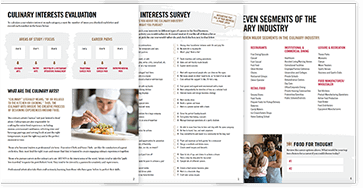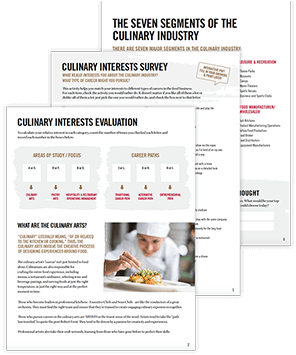While you can find apples at the grocers any time of the year, fall is the peak season and you’re bound to find fresh varieties at your local farmers market. The endless apple recipe vault is then perfect for this fresh-picked fruit. Apple pie recipes seem to be the most popular, but what about breaking out of the norm and trying something new? Escoffier baking and pastry students learn new techniques and recipes that help build their skillset which, in turn, helps them become more confident as they move forward in their culinary careers.
Follow along as Escoffier Baking and Pastry Chef Instructor Stefanie Bishop-Schmidt shares and demonstrates one of her favorite fall pastry recipes—Apple Turnovers!
Puff Pastry
Ingredients
- 400 g Butter A
- 225 g Water
- 25 g White Wine Vinegar
- 500 g AP Flour
- 10 g Salt
- 50 g Butter B – melted, but not hot
Method
- Pound butter A with a rolling pin between two pieces of parchment paper and flatten it into a rectangle 6 1/2 x 8 inches and 1/2 thick.
- Cover and chill the butter for at least 8 hrs- overnight.
- On low speed, add half of the water mix and mix for 30 seconds. Add more of the water reserving a small amount (which may not be needed). Mix, flour should be thoroughly moist.
- Slowly add the melted butter and mix until the dough comes together. At this stage, the dough should feel tacky but should not stick to fingers. If the dough is too dry, add the remaining water a little at a time as needed.
- Remove the dough from the mixer and knead on a lightly floured surface for several mins, the dough will not be smooth in texture and will resemble a bread dough consistency.
- Tuck the edges under to form a ball. Cut an X in the top about 1/2 deep to help the dough relax. Let dough rest, covered 8 hr- overnight in the fridge.
- Lightly flour your work surface. Roll dough outwards from the center to a 12-13 inch circle that is 3/8 inch thick. The dough should still be cold. Chill in the fridge if it gets too warm.
- Lay a butter block in the center of the dough. Stretch and fold the dough from each side over the butter to meet in the middle. Pinch edges together. No butter should be showing. The butter is now locked into the dough.
- Turn the dough so the short end faces you. Roll to a rectangle that is 24 x 9 inches and 3/8 inches thick.
- Fold the bottom third up as if you were folding a letter, and fold the top third over the bottom.
- Turn the block 90 degrees so it resembles a book, with the opening on the right.
- This completes the first turn, chill, and cover for 2 hours.
- Repeat the process, trimming the dough as needed to keep it square and resting after each turn. After turn 5, chill the dough for 8 hrs- overnight.
- At this point the dough can be wrapped tight and frozen until needed at a later time or rolled out and shaped for baking.
Apple Butter
Ingredients
- 1000 g Apples
- 120 g Apple cider vinegar
- 25 g White Wine Vinegar
- 240 g Water
- 2 g Gr. ginger
- 2 g Gr. Cinnamon
- 376 g Sugar
- 10 g Vanilla Paste
- 2 g Salt
Method
- Do not peel or core the apples. Roughly chop the apples and combine everything in a large pot with the vinegar and water.
- Cook on low heat, covered until they begin to break down, approx 1 hour.
- Pass apple mixture through a ricer or a large sieve to remove the seeds, core, and skins.
- Combine apple mix with spices, sugar, vanilla, and stir.
- Transfer mixture to an oven-safe dish and cover with foil. Bake at 330 degrees F until fully caramelized and thick, approx 2-3 hrs. You will need to stir the apple mix throughout cooking to prevent burning. The final butter should be a deep amber color.
- Cool and use as desired.
Egg Wash
Ingredients
- 1 Egg
- Pinch of Salt
Method
- Crack the egg into a container, add the pinch of salt. Whisk to incorporate, and strain mixture.
- Egg wash is ready to use and should only be kept 2-3 days in the fridge.
Apple Turnovers
Ingredients
- 1 recipe Puff Pastry
- As needed Apple Butter
- As needed Diced Apples (optional)
- As needed Egg Wash
Method
- Roll chilled puff pastry to 1/4 inch thick rectangle.
- Cut out desired portions using a ruler to measure a square or a fluted circle cutter.
- Place on prepared bake sheet lined with parchment paper.
- Spoon a small portion of apple butter onto the pastry, and top with apples if desired.
- Brush a 1 inch border around the edge of the pasrty with egg wash.
- Fold the top of the pastry over the filling to meet the bottom half of the pastry, press to seal the edges.
- Brush top of pastry with egg wash and chill.
- Preheat oven to 350 degrees F.
- Brush pastry a second time with egg wash.
- Using a sharp paring knife, score the top of the pastry with the design of your choice.
- Bake until golden 40-45 mins.
- Cool and serve, these are best eaten the day they are baked.
The Essential Culinary Career Survey The Essential Culinary Career Survey What's your ideal culinary career: Fine dining? Your own restaurant? Pastry? Get our self-evaluation survey to find out! We’ve compiled a checklist of all of the essential questions into one handy guide: career options, culinary interest surveys, educational opportunities, and more.


Check out these recipes next:

